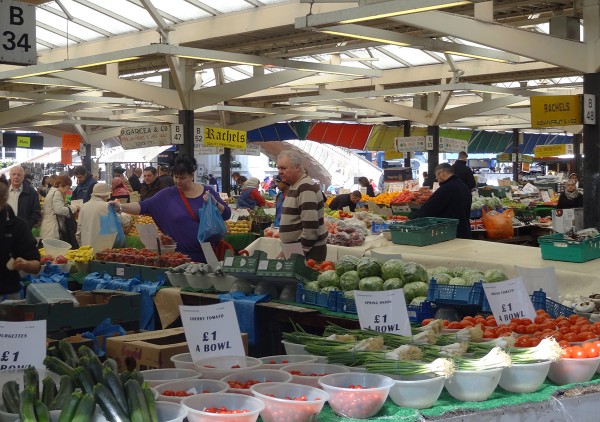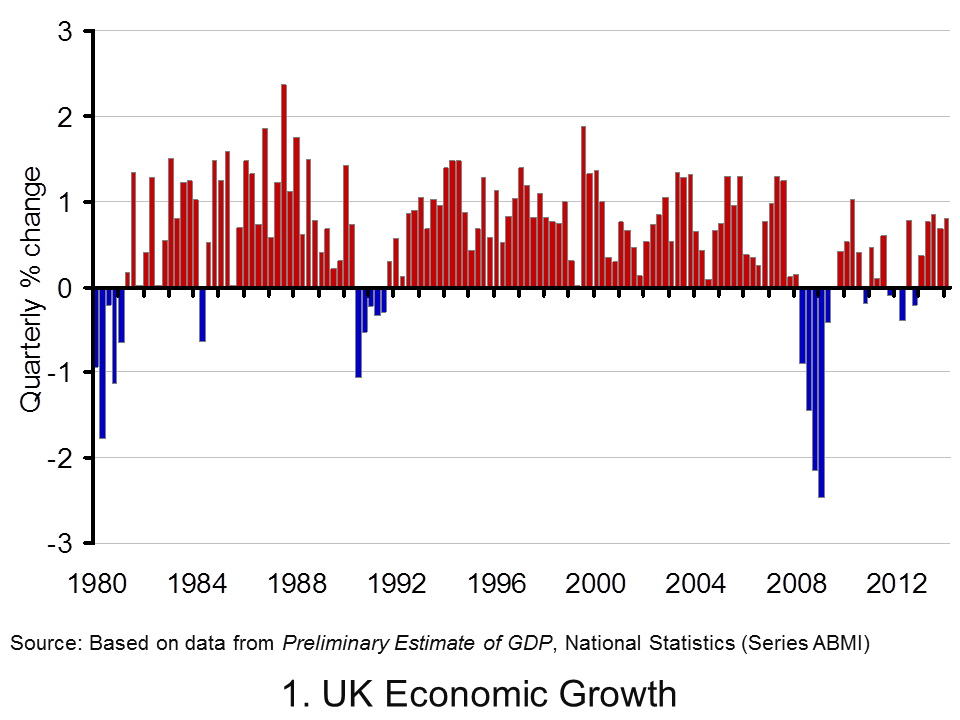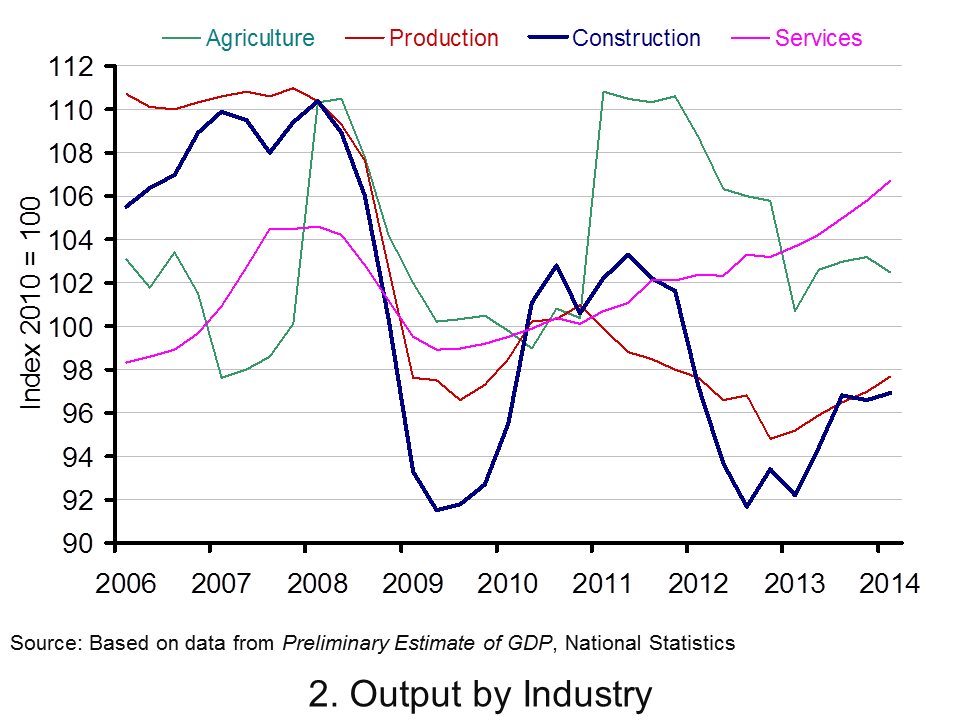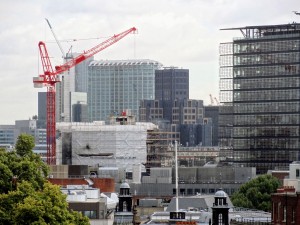 The latest preliminary GDP estimates for 2014 Q1 suggest that the economy’s output (real GDP) expanded by 0.8 per cent following on the back of a 0.7 per cent increase in 2013 Q4. Growth was observed in three of the four main industrial sectors: 0.9% in services, 0.8% in production and 0.3% in construction. In contrast, output decreased by 0.7% in agriculture. The total output of the economy is now just 0.6 per cent below its 2008 Q1 peak with the output of the service sector now 2.0 per cent higher.
The latest preliminary GDP estimates for 2014 Q1 suggest that the economy’s output (real GDP) expanded by 0.8 per cent following on the back of a 0.7 per cent increase in 2013 Q4. Growth was observed in three of the four main industrial sectors: 0.9% in services, 0.8% in production and 0.3% in construction. In contrast, output decreased by 0.7% in agriculture. The total output of the economy is now just 0.6 per cent below its 2008 Q1 peak with the output of the service sector now 2.0 per cent higher.
Data on growth need to be set in the context of the inherent volatility of economies and in this case in the context of 2008/9 recession. Then, output fall by some 7.2 per cent. UK output peaked in 2008 Q1 (£392.786 billion at 2010 prices). There then followed 6 quarters during which output declined.
Output declined again in 2010 Q4 (-0.2% growth), in 2011 Q4 (-0.1% growth), in 2012 Q2 (-0.4%) and in 2012 Q4 (-0.2%). A double-dip recession was only narrowly avoided with growth recorded at zero on 2012 Q1. The latest ONS numbers show the economy grew by 0.8 per cent in 2013 Q2 (to £381.318 billion at 2010 prices), by 0.8 per cent in 2013 Q3 (to £384.533 billion at 2010 prices), by 0.7 per cent in 2013 Q4 (to £387.138 billion at 2010 prices) and by 0.8 per cent in 2014 Q1 (to £390.235 billion at 2010 prices). Compared with 2013 Q1, the output of the UK economy in 2014 Q1 is 3.1 per cent higher.
 Chart 1 helps to put the recent growth numbers into an historical context. It shows the quarterly change in real GDP since the 1980s. We can see the 5-quarter recession that commenced in 1980 Q1 when output shrunk by 4.6 per cent, the 5-quarter recession that commenced in 1990 Q3 when output shrank by 2.4 per cent and the 6-quarter recession that commenced in 2008 Q2 when output shrank by 7.2 per cent. (Click here to download the chart to PowerPoint.)
Chart 1 helps to put the recent growth numbers into an historical context. It shows the quarterly change in real GDP since the 1980s. We can see the 5-quarter recession that commenced in 1980 Q1 when output shrunk by 4.6 per cent, the 5-quarter recession that commenced in 1990 Q3 when output shrank by 2.4 per cent and the 6-quarter recession that commenced in 2008 Q2 when output shrank by 7.2 per cent. (Click here to download the chart to PowerPoint.)
 Chart 2 scratches a little below the surface by looking at output by the 4 principal industrial types. The interesting finding is that the output of the service sector has now risen above its 2008 Q1 peak. In 2014 Q1, service sector output was 2.0 per cent higher than 2008 Q1. The fact that total output remains 0.6 per cent lower can be explained by the lop-sided industrial recovery. Output in agriculture, forestry and fisheries remains 7.1 per cent lower, production (including manufacturing) 11.5 per cent lower and construction 12.2 per cent lower. (Click here to dowload the chart to Powerpoint.)
Chart 2 scratches a little below the surface by looking at output by the 4 principal industrial types. The interesting finding is that the output of the service sector has now risen above its 2008 Q1 peak. In 2014 Q1, service sector output was 2.0 per cent higher than 2008 Q1. The fact that total output remains 0.6 per cent lower can be explained by the lop-sided industrial recovery. Output in agriculture, forestry and fisheries remains 7.1 per cent lower, production (including manufacturing) 11.5 per cent lower and construction 12.2 per cent lower. (Click here to dowload the chart to Powerpoint.)
Data
Preliminary Estimate of GDP – Time Series Dataset Q1 2014 Office for National StatisticsGross Domestic Product Preliminary Estimate, Q1 2014 Office for National Statistics
Articles
UK GDP ‘close to pre-crisis level’ says NIESR BBC News (9/5/14)
UK ‘great recession’ almost over, says thinktank Guardian, Katie Allen (9/5/14)
UK economy tops its pre-crash high point, says NIESR Telegraph, Szu Ping Chan (9/5/14)
UK economy grew by 0.8% in first three months of 2014 Guardian, Katie Allen and Angela Monaghan (29/4/14)
Manufacturing is GDP star performer BBC News, Robert Peston (29/4/14).
Questions
- What is the difference between nominal and real GDP? Which of these helps to track changes in economic output?
- Looking at Chart 1 above, summarise the key patterns in real GDP since the 1980s.
- What is a recession? What is a double-dip recession?
- What are some of the problems with the traditional definition of a recession?
- Can a recession occur if nominal GDP is actually rising? Explain your answer.
- What factors lead to economic growth being so variable?
- What factors might explain the very different patterns seen since the late 2000s in the volume of output of the 4 main industrial sectors?
- Produce a short briefing paper exploring the prospects for economic growth in the UK over the next 12 to 18 months.
- Explain the arguments for and against using GDP as a measure of a country’s economic well-being.
- Analyse the role that the financial system might play in contributing to or alleviating the business cycle.
 For years, Britain has suffered a decline in its manufacturing base relative to many of its competitors. In part this was the result of the success of the financial sector and the accompanying high exchange rate. But, with the problems of the financial sector since 2007 and the subsequent recession, attention has increasingly turned to ways of stimulating manufacturing capacity and the competitiveness of the export sector generally.
For years, Britain has suffered a decline in its manufacturing base relative to many of its competitors. In part this was the result of the success of the financial sector and the accompanying high exchange rate. But, with the problems of the financial sector since 2007 and the subsequent recession, attention has increasingly turned to ways of stimulating manufacturing capacity and the competitiveness of the export sector generally.
In other words, attention has turned to the supply side of the economy.
But what should be the features of a successful supply-side policy? Should it encourage competition and focus largely on deregulation and removing ‘red tape’ to encourage market forces to operate more efficiently and effectively? Or should it be more interventionist?
The Business Secretary, Vince Cable, has been in the headlines for criticising his own government’s policy and arguing for a more active supply-side policy – one that is more interventionist. The following podcasts, the second of which is an interview with Dr Cable, look at the arguments for a more active supply-side policy and the forms it could take. The articles look at some of the arguments in more detail.
Podcasts
 Industrial strategy ‘lacking in the UK’ BBC Today Programme, Mariana Mazzucato (6/3/12)
Industrial strategy ‘lacking in the UK’ BBC Today Programme, Mariana Mazzucato (6/3/12)
 Government ‘getting behind’ industry BBC Today Programme, Vince Cable (6/3/12)
Government ‘getting behind’ industry BBC Today Programme, Vince Cable (6/3/12)
Articles
Cable urges long-term plan for industry Financial Times, George Parker (12/2/12)
Cable defends concern over lack of vision Financial Times, Elizabeth Rigby and George Parker (6/3/12)
Vince Cable leaked letter: in full The Telegraph (6/3/12)
Rusting Britain threatens recovery The Telegraph, Alexander Baldock (4/3/12)
Vince Cable is Right: we “lack a compelling vision of where the country is heading” Birmingham Post, David Bailey (6/3/12)
Rebuilding Britain’s economy: the hunt for an ‘industrial strategy’ Citywire Money, Chris Marshall (29/2/12)
Companies must stop hoarding cash and start investing instead Observer, Will Hutton (19/2/12)
Britain needs to shape an industrial strategy Observer, Editorial (4/3/12)
Questions
- Distinguish between the terms ‘industrial strategy’, ‘market-orientated supply-side policy’ and ‘interventionist supply-side policy’
- Identify some ways in which innovations and productivity growth can be supported by government.
- Does interventionist supply-side policy inevitably involve the government spending more?
- If the government wishes to encourage a more entrepreneurial country, should this involve a careful mix of intervention and market liberalisation and, if so, what should the mix look like?
- Summarise the arguments in Vince Cable’s letter to the Prime Minister and Deputy Prime Minister.
- What are the lessons of Silicon Valley for the UK and other European countries?
- How important is successful demand-side policy for a successful supply-side strategy?
- Comment on the following quote from the Will Hutton article above: “British companies are running a cash surplus of some 6% of GDP, again the largest in the world, but are refusing to spend that cash on investment or innovation, preferring to hoard it, preserve profit margins or buy back their own shares. Business investment as a share of GDP is thus the lowest among large industrialised countries.”
There’s some good news and some bad news concerning the balance of payments, according to figures just released. First the good: the trade in goods and services deficit narrowed from £4.89bn in August to £4.57bn in September; and the trade in goods deficit narrowed from £8.47bn to £8.23bn. Now the bad: the trade in goods and services deficit rose from £12.63bn in quarter 2 to £14.28bn in quarter 3 and the trade in goods deficit rose from £19.72bn to £21.33bn over the same period.
This is worrying as the recovery depends to a large part on a recovery in exports. These rose by only 1.36% from quarter 2 to quarter 3, whereas imports rose by 3.33%. And this is despite a fall in the exchange rate of the pound against the UK’s trading partners over the past four years. Looking at the quarter 3 figures, the exchange rate index was 104.3 in 2007, 91.6 in 2008, 82.9 in 2009 and 81.8 in 2010. What is also worrying is a very modest rise in manufacturing output.
Articles
UK’s September trade deficit smallest since June BBC News (9/11/10)
Record trade deficit for UK Guardian, Larry Elliott (9/11/10)
Britain’s trade gap: What the economists say Guardian (9/11/10)
Data
UK Trade National Statistics
Statistical Bulletin: UK Trade September 2010 National Statistics
United Kingdom Balance of Payments – The Pink Book National Statistics (Balance of payments data going back many years)
Statistical Interactive Database: Effective exchange rates Bank of England
Questions
- How is a depreciation of its currency likely to affect a country’s balance of payments?
- What are the requirements for the UK to achieve an export-led recovery?
- Why did the UK’s balance of trade deteriorate between Q2 and Q3 of 2010?
- How might supply-side policy affect the balance of trade?
- What determines the income elasticity of demand for (a) UK imports; (b) UK exports?
GDP (or Gross Domestic Product) measures the value of output produced within a country over a 12-month period. It is this figure which we use to see how much the economy is growing (or shrinking). We can also look at how much different sectors contribute towards this figure. Over the past few decades, there has been a significant change in the output of different sectors, as a percentage of GDP, within the UK economy. In particular, the contribution of manufacturing has diminished, while services have grown rapidly.
However, there is one specific area that is making a growing contribution towards UK GDP and is expected to see acceleration in its growth rate by some 10% annually over the next few years: the internet. Although the internet is not an economic sector, the Boston Consulting Group (BCG) said that if it was, it would be the UK’s fifth largest sector and according to a report by Google, it is worth approximately £100 billion per year to the UK economy. Furthermore, it is an area in which the UK is one of the leading exporters. The emergence of the internet has transformed industries and individual businesses and the trend looks set to continue. The report by Google found that some 31 million adults bought goods and services online over the past year, spending some £50 billion.
What are the benefits for businesses of internet shopping and does it have an impact on the retail outlets on Britain’s highstreets? The answer is undoubtedly yes, but is it good or bad? What does the emergence of this new ‘sector’ mean for the UK economy?
Articles
UK net economy ‘worth billions’ BBC News (28/10/10)
UK’s internet industry worth £100 billion report Guardian, James Robinson (28/10/10)
’Nation of internet shopkeepers’ pumps £100 billion into economy Independent, Nick Clark (28/10/10)
UK internet is now worth £100bn to UK economy Telegraph, Rupert Neate (28/10/10)
Google at 10 BBC News, Success Story, Tim Weber (4/9/08)
Britain’s £100bn internet economy leads the world in online shopping Guardian, James Robinson (28/10/10)
Report
How the internet is transforming the UK economy The Boston Consulting Group October 2010
Government Statistics
United Kingdom: National Accounts, The Blue Book 2009 Office for National Statistics 2009 edition
Questions
- What is the UK’s GDP? How does it compare with other countries and how has it changed over the past 10 years?
- How does internet provision contribute towards growth? Think about the AD curve. Illustrate this on a diagram and explain the effect on the main macroeconomic objectives.
- Is there a problem with becoming too dependent on this emerging sector?
- How has the internet and online environment helped businesses? Think about the impact on costs and revenue and hence profits.
- What explanation is there for the change in the structure of the UK economy that we have seen over the past few decades.
- Will internet shopping ever replace the ‘normal’ method of shopping? Explain your answer.
The pound is regarded as an international currency, but its value has been declining throughout the financial crisis. Indeed, this downward trend is one of the factors that has prevented the recession in the UK from getting worse. As the exchange rate changes, the relative competitiveness of a country’s products changes and this therefore affects exports and imports.
However, despite a declining pound, exports from the UK have fallen and this has contributed to an unexpected global goods trade deficit in January of nearly £8 billion – the largest level since August 2008 and well above the forecast of £7 billion. This is putting further pressure on the pound. A key to the UK’s economic recovery was argued to be growth in exports, but this now appears to be a somewhat forlorn hope. The figures released show that exports slumped 6.9% to £19.5 billion in January, whilst imports only fell by 1.6%. A contributing factor might be the bad weather that hit the UK in January, but the long-term decline of manufacturing in Britain has also been put forward as a reason.
The following articles consider the UK’s trade deficit and the possibility of an export-led recovery.
Articles
January trade deficit widens as exports fall Guardian, Kathryn Hopkins (9/3/10)
UK trade gap widens to worst in 17 months BBC News (9/3/10)
Exports plunge heaps pressure on pound Independent (9/3/10)
Pound slides back against dollar and euro Guardian, Ashley Seager (21/9/09)
Trade gap widens despite weak pound Financial Times (9/3/10)
UK exports plunge by £1.4 billionThe Press Association (9/3/10)
Pound falls again on deficit fears Guardian (9/3/10)
UK trade gap widens as exports sink Wall Street Journal, Nicholas Winning (9/3/10)
Rebalancing, deferred BBC News blogs, Stephanomics Stephanie Flanders (9/3/10)
Global recovery is helping UK, says Bank of England’s Sentance Guardian, Larry Elliott (18/3/10)
Pound Declines as Investors Bet Bank of England Will Hold Rates BusinessWeek, Lukanyo Mnyanda (20/3/10)
Data
For UK balance of trade data, see UK Trade (Office for National Statstics)
For exchange rate data, see Statistical Interactive Database (Bank of England)
Questions
- How is the value of the pound determined?
- Illustrate a depreciation of the pound on a diagram. What are the factors that could cause this?
- When the value of the pound falls, why should UK goods become more competitive?
- Explain why an export-led recovery was a possibility for the UK economy. How can we use the transmission mechanisms to help explain this?
- Despite a weak pound, exports have fallen. What are the explanations for this?
- What are the consequences of a widening trade deficit and how can it be tackled?
 The latest preliminary GDP estimates for 2014 Q1 suggest that the economy’s output (real GDP) expanded by 0.8 per cent following on the back of a 0.7 per cent increase in 2013 Q4. Growth was observed in three of the four main industrial sectors: 0.9% in services, 0.8% in production and 0.3% in construction. In contrast, output decreased by 0.7% in agriculture. The total output of the economy is now just 0.6 per cent below its 2008 Q1 peak with the output of the service sector now 2.0 per cent higher.
The latest preliminary GDP estimates for 2014 Q1 suggest that the economy’s output (real GDP) expanded by 0.8 per cent following on the back of a 0.7 per cent increase in 2013 Q4. Growth was observed in three of the four main industrial sectors: 0.9% in services, 0.8% in production and 0.3% in construction. In contrast, output decreased by 0.7% in agriculture. The total output of the economy is now just 0.6 per cent below its 2008 Q1 peak with the output of the service sector now 2.0 per cent higher.  Chart 1 helps to put the recent growth numbers into an historical context. It shows the quarterly change in real GDP since the 1980s. We can see the 5-quarter recession that commenced in 1980 Q1 when output shrunk by 4.6 per cent, the 5-quarter recession that commenced in 1990 Q3 when output shrank by 2.4 per cent and the 6-quarter recession that commenced in 2008 Q2 when output shrank by 7.2 per cent. (Click here to download the chart to PowerPoint.)
Chart 1 helps to put the recent growth numbers into an historical context. It shows the quarterly change in real GDP since the 1980s. We can see the 5-quarter recession that commenced in 1980 Q1 when output shrunk by 4.6 per cent, the 5-quarter recession that commenced in 1990 Q3 when output shrank by 2.4 per cent and the 6-quarter recession that commenced in 2008 Q2 when output shrank by 7.2 per cent. (Click here to download the chart to PowerPoint.)  Chart 2 scratches a little below the surface by looking at output by the 4 principal industrial types. The interesting finding is that the output of the service sector has now risen above its 2008 Q1 peak. In 2014 Q1, service sector output was 2.0 per cent higher than 2008 Q1. The fact that total output remains 0.6 per cent lower can be explained by the lop-sided industrial recovery. Output in agriculture, forestry and fisheries remains 7.1 per cent lower, production (including manufacturing) 11.5 per cent lower and construction 12.2 per cent lower. (Click here to dowload the chart to Powerpoint.)
Chart 2 scratches a little below the surface by looking at output by the 4 principal industrial types. The interesting finding is that the output of the service sector has now risen above its 2008 Q1 peak. In 2014 Q1, service sector output was 2.0 per cent higher than 2008 Q1. The fact that total output remains 0.6 per cent lower can be explained by the lop-sided industrial recovery. Output in agriculture, forestry and fisheries remains 7.1 per cent lower, production (including manufacturing) 11.5 per cent lower and construction 12.2 per cent lower. (Click here to dowload the chart to Powerpoint.) 
